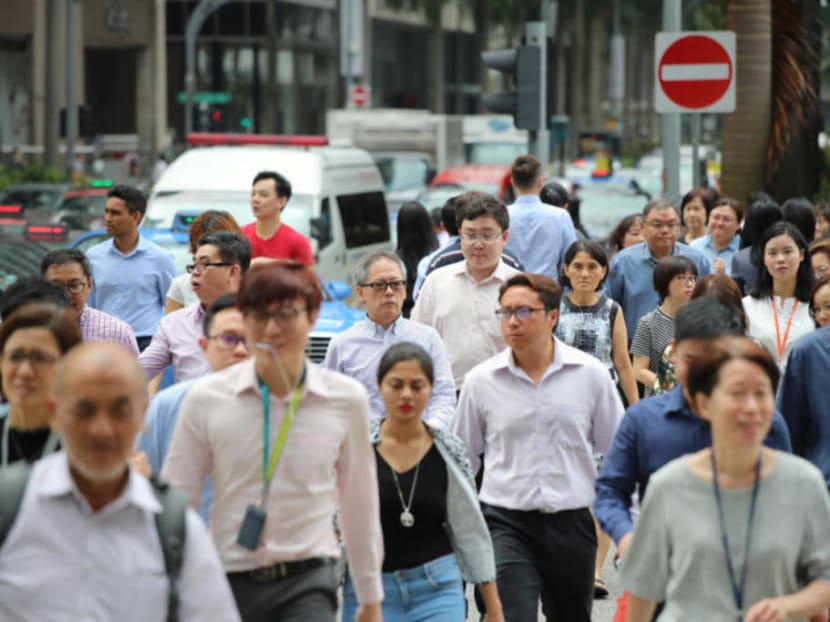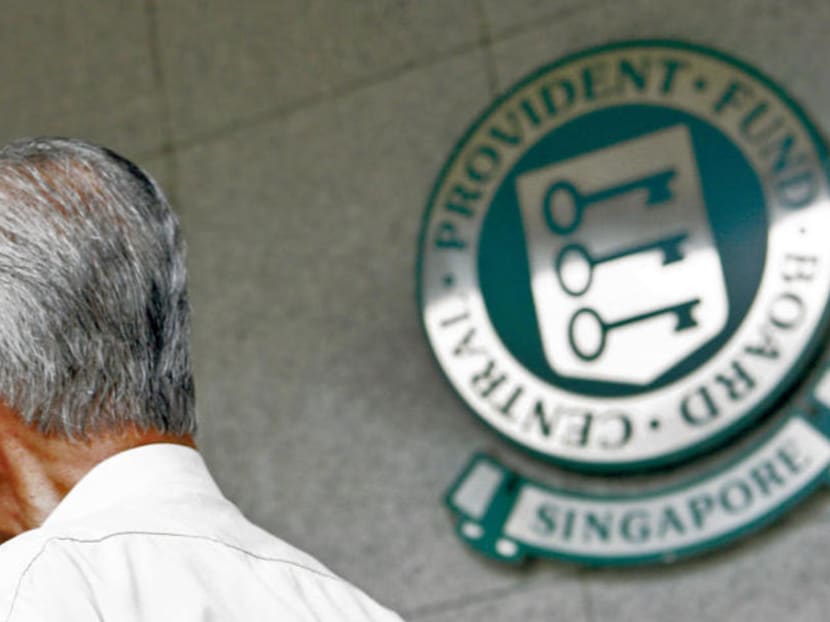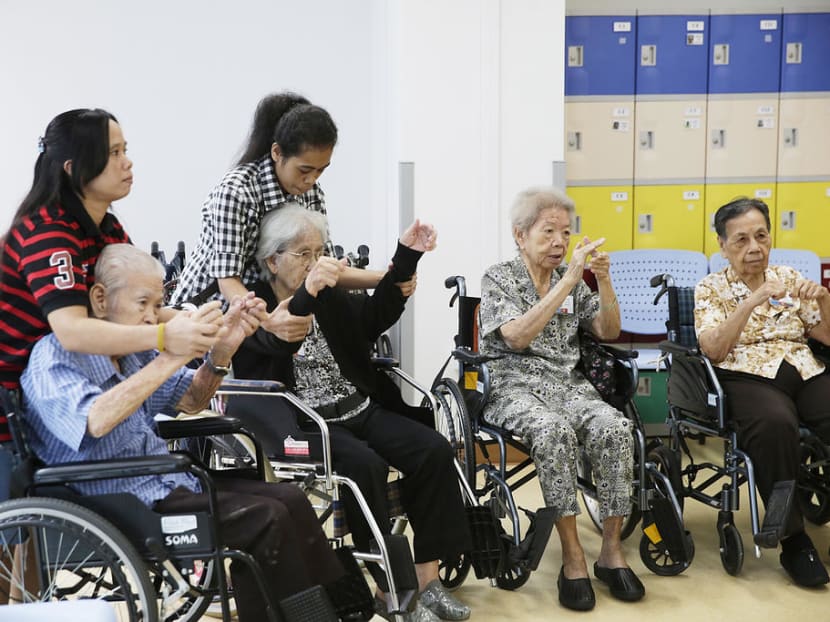The Big Read: The dreaded ‘R’ word — why Singaporeans need to start thinking seriously about retirement
SINGAPORE — Published last month, the latest Household Expenditure Survey — conducted every five years — found that retiree households living in public flats here receive an average of S$1,522 each month for their retirement needs, with the bulk of it coming from their children or relatives.

In the coming years, Singapore will have to grapple with mounting, multifaceted challenges that have already put a strain on the financial security of today’s retirees — and will create greater uncertainties for tomorrow’s silver generation.
SINGAPORE — Published last month, the latest Household Expenditure Survey — conducted every five years — found that retiree households living in public flats here receive an average of S$1,522 each month for their retirement needs, with the bulk of it coming from their children or relatives.
This is the breakdown: S$280 from Central Provident Fund (CPF) payouts; S$485 from familial transfers; S$180 from personal investments; S$178 from rental income including proceeds from subletting or Lease Buyback Scheme for example; and S$399 from other sources, including pensions and government aid.
Amid growing concerns among experts and policymakers over retirement adequacy in Singapore, the statistics provide a snapshot of how today’s retirees are meeting their needs.
The current reality, however, is quite different from what some young Singaporeans have in mind — at least the rare few who have started thinking about retirement adequacy — when their turn comes to enjoy their golden years.
Account manager Fiona Dawn Cher, 29, for one, has a plan: 60 per cent of her retirement funds should come from investment income, 30 per cent from her CPF, and 10 per cent from her personal savings.
Ms Cher, who runs a blog on personal finances where she goes by the moniker SG Budget Babe, does not intend to rely on financial support from children and relatives, or rental income from owning her home.
If she has the choice, she would want to use more of her CPF funds to invest.
Unlike Ms Cher, many young Singaporeans have yet to give much thought about how to meet their retirement needs.
“I see that when my younger readers write to me… some only want stock tips while others jump into investments that they barely understand,” said Ms Cher.
Around 65 per cent of Singaporeans are behind in accumulating funds to maintain their lifestyles after retirement, and 73 per cent are “not on track” with their retirement plans, based on OCBC’s inaugural Financial Wellness Index this year which measures the state of financial health in Singapore.
Retirement will be a key topic during the National Day Rally on Sunday, Prime Minister Lee Hsien Loong had said earlier. Among other things, Mr Lee will be speaking on the raising of the re-employment and retirement ages — currently at 62 and 67 respectively — for those who wish to work longer.
Indeed, in the coming years, Singapore will have to grapple with mounting, multifaceted challenges that have already put a strain on the financial security of today’s retirees, and will create greater uncertainties for tomorrow’s silver generation, a range of experts — economists, sociologists and financial consultants — and union leaders told TODAY.
Apart from an ageing population, demographic trends such as rising singlehood, smaller family sizes, dwindling fertility rates and longer life expectancies would have an impact.
With regard to the workforce, there are factors such as possible labour scarcity and technological disruption. At the same time, property values, rising costs and standard of living, as well as the increasingly volatile global economy would affect Singaporeans’ ability to fund their retirement.
Add to that the lack of financial literacy among the general population and the risk of overburdening the CPF system which has evolved over the years to take on multiple needs in the areas of retirement, education, homeownership as well as healthcare.
There is concern among experts and policymakers that Singaporeans in general are not thinking hard enough or preparing adequately for their retirement. Among other things, there is a lack of awareness about how much is needed.
There is also a mistaken belief among some Singaporeans that their CPF savings alone are sufficient for retirement. While this was made clear by policymakers from the start — the system was designed to be just one of a few components of retirement adequacy — the message has not quite sunk in.
A poll of 1,000 respondents by market research consultancy Blackbox — which was released in June — found that 62 per cent of Singaporeans feel they are not saving enough for old age. This figure rises to 74 per cent among households earning less than S$2,500 a month. The poll also found that 43 per cent of respondents said they were relying mainly on CPF, while 38 per cent said personal savings and 17 per cent said investments.
Speaking to TODAY, Ms K Thanaletchimi, the president of the Healthcare Services Employees' Union (HSEU) and a former Nominated Member of Parliament (NMP), said: “The message should be stark and clear. CPF payouts should not be the main source of income for a retiree. It must be regarded as a complementary or supplementary source of income for Singaporeans.”
Adding that many Singaporeans “also do not really understand the workings of CPF”, the unionist lamented the general lack of understanding about retirement adequacy and financial planning, with many younger adults in particular being oblivious to the need to think long-term about their retirement.

CPF: MALIGNED AND MISUNDERSTOOD?
Established in 1955, the CPF system is a compulsory savings scheme “designed to help Singaporeans take care of these needs and support themselves in retirement”, according to the CPF Board’s website. It noted that this is supplemented by targeted assistance provided by the Government to the needy through subsidies and top-ups.
Mention “CPF” today, and one is likely to elicit sharply divided views: On one hand, there are those who criticise the Government for “locking up” their money and demand that it be “returned” to them, so that they can use the money as they deem fit.
On the other hand, some wish that they can leave their money in CPF for as long as possible. One of them is retiree Eddie Goh, who has made repeated requests for the CPF Board and the Manpower Ministry to keep his money in his CPF accounts.
At 65, he can start drawing down his CPF in monthly payouts for his golden years. And while payouts automatically begin at 70, he wishes that he can leave his CPF monies intact to accrue interest until he is in his early 80s when his health would presumably decline.
“The Government is always saying that this monthly payout is a retirement income stream,” he said. “But I told them, this stream would become a trickle as time goes on.”
In a commentary published by TODAY earlier this week, Institute of Policy Studies senior research fellow Christopher Gee addressed the question of who does CPF money belongs to — a question which “comes up regularly in Singapore”, he noted.
Stressing the “collective strength” of the CPF system, Mr Gee pointed out that “the real tension is between the individual preferences and society’s broader interests”.
“This is because the CPF is more than just a system of individual pension accounts, much more so than Individual Retirement Accounts in the United States (otherwise known as 401(k) plans), or the Individual Savings Account in the United Kingdom,” he wrote.
Speaking at the Economics Society of Singapore’s annual dinner in 2016, then Deputy Prime Minister Tharman Shanmugaratnam said as much: “Our CPF system is essentially – and this is not commonly understood – it is essentially both individual and collective. And it is governed by rules to ensure fairness, progressivity, and sustainability. It’s not a perfect scheme.”
But doing so has avoided the problems seen in pension schemes in other countries, said Mr Tharman. Social transfers, such as those from the Workfare Income Supplement Scheme and other social support schemes, are provided for through the Budget and injected into CPF accounts yearly in a way which favours the needy and to a smaller extent, the middle-income groups.
“What we have done essentially is unlike the traditional collective schemes in the advanced countries, we have sought to provide fair and progressive benefits for the low-income group – not by transfers between generations or by the pretence of the accounting rules that allow for a pretence that you can pay out more than you actually can afford.”
In his speech, Mr Tharman also noted the simplicity of the CPF system in the early years.
“People were by and large poor, didn’t own their homes, and the CPF was really a very simple scheme,” said Mr Tharman, who is now Senior Minister.
He added: “It was in fact not really a retirement savings scheme. It was a savings scheme for home ownership first and foremost, with very modest amounts being set aside for retirement. That’s what the CPF system was, there was no special account, no retirement account, no minimum sum, no Medisave account.”
When the CPF system came into effect in 1955, the average Singaporean lifespan was 60 — just five years more than the retirement and CPF withdrawal age of 55 at the time.
By and large, the system worked fine for almost four decades. In the mid-’90s, the Government began tweaking the system as Singaporeans’ incomes grew. With most people owning their homes, CPF’s focus moved to boosting cash savings for retirement — limits were imposed on withdrawals for housing and the interest rates of CPF savings were raised.

LIMITATIONS AND THE ‘KEY RISK’
Based purely on contributions from its members, the CPF, however, could not address retirement adequacy of segments of the population such as workers in low-wage and casual jobs, non-working mothers as well as elderly CPF members, National University of Singapore Associate Professor Chia Ngee-Choon wrote in a 2015 paper calling for a new pillar of retirement for these workers.
Some economists argue that these issues affecting the vulnerable groups continue today — for example, the growing gig economy consists of casual workers who do not contribute to CPF.
Compared with the past, the CPF, as well as the entire retirement security system, now faces greater labour market risks that affect all members, instead of particular segments, the experts said.
OCBC Bank head of investments and wealth advisory Kelvin Goh said: “Job certainty in this day and age is increasingly a distant prospect, with an uncertain global economy, increased use of automation and the rise of the gig economy. Preparing for retirement will now be very different as compared to the past.”
Nevertheless, experts including Mr Goh noted that the key risk to retirement adequacy and the CPF system is longevity risk whereby a retiree outlives his or her income stream.
Based on the latest national data, the average life expectancy of a newborn Singaporean is 83.2, which means that half of the population will live beyond 83. For Singaporeans aged 65, their average life expectancy is 21.1 years, with women living longer than men by more than three years, based on national data. A third of Singaporeans will live beyond 90 years old.
Against this backdrop of increasing life expectancy, CPF Life was introduced a decade ago. This annuity scheme that gives lifelong payouts from the payout eligibility age — currently set at 65 for those born after 1954 — accounts for longevity risks by pooling together the funds of members’ Retirement Accounts, and sharing the interests earned among all members, including those who live longer than the average lifespan.
The basic design of the CPF as an individual savings scheme remains the same despite frequent revisions to the CPF contribution rates and withdrawal rules over the years, said Assistant Professor Ng Kok Hoe from the Lee Kuan Yew School of Public Policy.
“Economic and demographic developments add to the well-recognised constraints of the CPF, such as a lack of redistribution to lessen labour market inequalities, a high contribution rate that limits the scope for personal savings and investment, and intensive housing consumption which results in low cash income replacement rates in retirement,” he said.
In May, Dr Ng and a team of researchers, including Nanyang Technological University Associate Professor Teo You Yenn, found that by today’s minimum income standards, a benchmark of S$1,379 a month per senior is needed to meet basic standards of living in retirement.
It takes into account the basic standard of living that is agreed upon through discussions and consensus among a large group of participants. The methodology used in the study is applied in the United Kingdom, said Dr Ng, and “reflects people’s lived realities and shared understanding of basic needs”.
Only 55 per cent of CPF members who turned 55 in 2013 had reached the Basic Retirement Sum (BRS). Those who set aside the BRS will receive S$730 to S$790 a month as of 2019.
This means that the remaining 45 per cent of members will receive less than S$730 a month from CPF payouts alone.
Nevertheless, CPF members without a property or who wish to receive the full monthly payout can choose to set aside a Full Retirement Sum which is two times the BRS. They will receive S$1,350 to S$1,450 a month as of 2019.
The payouts will rise further for those who set up the Enhanced Retirement Sum, which is three times the BRS. Under this arrangement, CPF members will receive S$1,960 to S$2,110 a month as of 2019.
DWINDLING FAMILY SUPPORT
Underpinning the Government’s social policies — including the CPF system — are individual effort and responsibility for the family.
The latest Household Expenditure Survey showed that out of the total income of retiree households living in Housing and Development Board (HDB) flats, contributions from children, relatives as well as friends residing elsewhere make up 32 per cent of their retirement income on average.
This is the largest component of retirement income among HDB residents, compared with the 18 per cent from CPF annuities and monthly payouts.
However, with total fertility rates falling steadily since the turn of the century, leading to smaller household sizes, as well as a growing number of Singaporeans who remain single, experts point out that family financial support would decline as a source of retirement funding.
Three separate polls — the National Survey of Senior Citizens in 1995, 2005 and 2011 — indicate that this is already the case. Assoc Prof Chia noted that the latest poll — conducted by researchers Kang Soon Hock, Yap Mui Teng and Tan Ern Ser — showed that income transfer from children was diminishing as the most important source of financial support for the elderly.
Speaking to TODAY, Assoc Prof Tan said that seniors who are 75 and older are likely to have to depend on their adult children to support them in old age. The NUS sociologist added that over time, successive generations are less likely to count on family support and believe more in self-reliance, as they recognise that family members have their own heavy financial commitments.
Still, Assoc Prof Walter Theseira, an NMP and economist from the Singapore University of Social Sciences, felt that more official data on family transfers is needed.
He said: “Many people have pointed out to smaller families as a reason why family support could be expected to be lower in the future, but the relationship isn’t so simple — it depends also on whether children have the financial ability to support their parents.”
Rather than solely due to shrinking family sizes, he suggested that the dwindling family support could have been a result of the Government's expanding role in retirement financing.
Nevertheless, IPS’ Mr Gee said that as retiree households of the Merdeka and Pioneer generations depend more on family support in retirement, those that lack strong financial support from their children or relatives would have to “reduce their expenditure, tap community or government financial support schemes, and sell off assets, including their homes”.
“In short, with Singapore’s demographic trajectory, familial support is likely to play a lesser role in post-retirement income security whilst the reliance on other sources will likely increase,” he said. This would include gains from property, he added.
HOME OWNERSHIP AS A SECURITY BLANKET
With more than 90 per cent of Singaporeans owning their homes, no retirement plan is complete without factoring in potential rental income.
“Over the years, the CPF Ordinary Account has been opened for withdrawals for authorised uses, primarily for buying property, paying for approved investment-linked insurance products and for higher education fees at local institutions,” noted Mr Gee.
“Particularly because of the connection with housing finance and that so many Singaporeans utilise their CPF Ordinary Account balances to pay for housing, there is a very strong interconnection between the housing sector, especially public housing, and Singaporeans’ retirement security.”
The Government has encouraged home ownership as one of four pillars of social security — alongside CPF, healthcare assurance and additional support for older low-wage Singaporeans through Workfare.
Noting that the policy has led to asset-rich and cash-poor seniors, Mr Gee pointed out that the Government has introduced property monetisation options such as the Lease Buyback Scheme.
For HDB flats which are sold on 99-year leases, Singaporeans aged 65 or older can choose to sell back to HDB the remaining lease on their homes through the scheme, monetising their flats for retirement purposes.
The scheme, launched in 2009 and enhanced twice in 2015 and at the start of this year, provides a stream of income during retirement years while allowing eligible Singaporeans to continue living in their flats.
The scheme has been lauded by property analysts and provides for income security, even as home values fall towards the tail-end of the lease, at which point the flat has zero monetary value and the land it sits on is returned to the HDB.
Other schemes, such as the HDB’s Voluntary Early Redevelopment Scheme and the Home Improvement Programme, aim to preserve the value of older flats.
But some analysts also warned of pitfalls when people over-rely on rental income and property windfalls for retirement, given the vagaries of the property market in recent years.
Dr Ng said that as the stock of public housing matures, housing assets “cannot always translate into adequate retirement income”.
Mr Tharman in 2016 also recognised that future generations cannot reap the same property gains as past cohorts of Singaporeans.
“The younger generation, you can’t count on the same home equity appreciation that you saw in the last 30 years, but we now have a system of enhanced interest rates, a system of Workfare throughout your life if you are lower income, and a system of housing grants that’s very significant,” he said.

In May, the Government changed CPF rules for older flats, such that younger buyers of resale flats with leases that expire before they turn 95 will be able to use less of their CPF balances for the purchase.
Older couples, conversely, can now draw more from their CPF savings and get a larger HDB loan for older resale flats.
Institute of Real Estate and Urban Studies director Sing Tien Foo and senior research associate Eileen Kuan wrote in a commentary published by TODAY in June: “What this may also mean is that as buyers age, they will increasingly see their property purchases more as a consumption decision rather than an investment.”
When it comes to property investments, Assoc Prof Theseira noted that one main challenge is a lack of financial education, where even if a person has the means, he or she does not end up making choices that experts regard as sensible for retirement security.
He said: “It is rather common for Singaporeans to over-invest in some asset classes such as property, which has done well historically, but which is not well diversified, putting a retirement (plan) based on property income at high risk (of being subjected) to property market trends.”
INVESTMENT INCOME AND FINANCIAL LITERACY
While having a diversified portfolio for retirement is ideal, studies have shown that most Singaporeans do not take active ownership of their retirement plans.
OCBC’s Mr Kelvin Goh pointed out that 34 per cent of Singaporeans do not invest at all, according to his bank’s Financial Wellness Index. Nearly half of Singaporeans also have zero passive income.
The latest Household Expenditure Survey found that on average, investment income make up around 12 per cent of HDB retiree household income. In sharp contrast, it comprises more than half of the retirement income of families living in private property.
Yet, just like property, investments can be a double-edged sword as a source of retirement income, since it is also subject to market fluctuations.
The CPF Investment Scheme (CPFIS) allows members to invest their CPF Ordinary Account savings into a wide range of investment products, but they bear the risks of the investment.
Another lower risk investment scheme that taps CPF monies, the Lifetime Retirement Investment Scheme, was announced in 2016 to simplify choices for CPF members, though it has yet to be rolled out.
The Government has in the past repeatedly cautioned that those without the appetite for such risks, or those lacking financial knowledge or time to invest, are generally better off leaving their CPF savings to earn risk-free interest rates that are guaranteed by the Government.
In the 2018 financial year, only 38 per cent of CPFIS members registered profits above the Ordinary Account interest rate of 2.5 per cent per annum, compared with 74 per cent in the previous financial year, Manpower Minister Josephine Teo said earlier this month in response to a parliamentary question from West Coast Group Representation Constituency Member of Parliament Foo Mee Har.
The large fall coincides with the escalation of trade tensions between the United States and China, which has dampened business confidence and investment globally.
Even though a retirement income stream through investments may not be for all, experts and observers stressed the need for greater financial literacy.
Urging for more outreach and awareness in schools and workplaces, Ms Thanaletchimi said even simple lessons by parents to their children, such as the importance of saving and how to grow their savings prudently, would help.
ELDERLY EMPLOYMENT
For older Singaporeans who have “missed out” on these lessons on retirement planning, there is a “dire need” to ensure that they are able to continue working in order to build up their savings for retirement, she added.
Nevertheless, she noted that in a recent survey by the HSEU, a majority of those above 55 polled preferred early retirement despite knowing the difficulties in funding their retirement over a longer time.
Assoc Prof Theseira said with the demographic and economic challenges today, as well as with the rising standard of living, working till an older age is one way to increase an individual’s financial resources for retirement. Otherwise, the rest of the country would have to bear the financial burden through taxes or the use of reserves, he noted.
Based on government data, resident employment rates among seniors have been rising every year.
A 2018 study by the Duke-NUS Medical School’s Centre for Ageing Research and Education (CARE) also found that 53.7 per cent of respondents aged between 60 and 69 were working either full-time or part-time. The figure fell to 25.2 per cent for those aged 70 to 79, and 3.9 per cent for those above 80.
Out of those working, 77 per cent of elderly respondents said they did it for the income. Around 50 per cent said it was to maintain good health, while 40.7 per cent said it was because they enjoyed working. About a third (31.1 per cent) said they desired to maintain social contact with others, while 17.8 per cent and 5.6 per cent indicated they wanted to contribute to society and to pass the time, respectively.
With the health-adjusted life expectancy currently at 74.2, Mr Gee and fellow IPS researcher Damien Huang recently argued for the retirement and re-employment ages to rise in tandem with Singaporeans’ healthier lives.
Both ages are set to rise, with the Government expected to announce the details soon, having flagged the changes several months ago.
EXPERTS SPLIT ON CPF’S FUTURE DIRECTION
As the challenges mount for Singapore’s retirement security and shape how each batch of Singaporeans derive their retirement income, the Singapore’s retirement adequacy framework — with CPF as the bedrock — will have to transform too, some experts told TODAY.
However, there is little consensus on the CPF system’s future direction.
The CPF has, for all intents and purposes, evolved to meet housing, education, and healthcare needs. Some proportion also go to investment and purchasing endowment insurance policies, noted Assoc Prof Tan.
Assoc Prof Theseira said: “It is debatable whether we should have broadened the CPF thus, or achieved the same policy outcomes through non-CPF policy.”
Citing Medisave for example, he said there is “no inherent reason” why medical costs should be integrated with CPF as other countries do it through dedicated medical insurance schemes or medical taxes. “But CPF has proven to be an adaptable system so we have parked most of our social security policies under it,” he added.
Mr Gee suggested that housing finance be further de-linked from CPF. “I'm not sure the CPF can be all things to all people; indeed there is an argument that the CPF already tries to do too much,” he said.
For the bottom 20 per cent households, Dr Ng felt that there is a need for more comprehensive measures outside of the CPF system. “The current challenges with the CPF cannot be addressed within the parameters of the CPF system,” he said.
Assoc Prof Theseira noted that unlike most other pension policies, the CPF is designed as an investment system rather than as a tax system. “But the outcome is the same – you get a retirement benefit because of your accumulated payments,” he said.
He added that it is in fact one of the most transparent retirement policies around the world because it accumulates contributions into an account anyone can see at any point, but it is also considered by segments of the public in Singapore as opaque and hard to understand because of the rules around withdrawal.
Assoc Prof Theseira summed it up: “As a retirement policy, the CPF faces an interesting paradox.”








